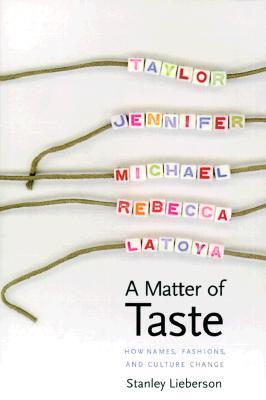A Matter of Taste Summary

6 min read ⌚
 How Names, Fashions, and Culture Change
How Names, Fashions, and Culture Change
It’s quite paradoxical, when you think about it!
In a world which has acknowledged Frank Sinatra’s “My Way” as its unofficial anthem, it’s getting harder to be unique! Fashion styles seem to come and go incessantly: blink, and you’ll miss the last one.
“A Matter of Taste” teaches you a thing or two about the reasons which make some things fashionable and render others outdated.
And we’ll summarize the key points here.
Who Should Read “A Matter of Taste”? And Why?
“A Matter of Taste” is not exactly your typical book about fashion. After all, its author, by the looks of his portfolio, seems much more likely to watch NatGeo over FashionTV any day of the year.
With that being said, “A Matter of Taste” may be still interesting to fad followers and fashion designers. The reason? It tries to uncover the secret ways, “the pure mechanisms” by which fashion operates. To do this, the book studies carefully how first name popularities change over time and why.
Consequently, even if you are simply in the process of choosing your child’s name, you might get an interesting insight from Lieberson’s research.
About Stanley Lieberson
 Stanley Lieberson is a Montreal-born sociologist whose focus is mostly the American society. He obtained his M.A. and Ph.D. in Sociology from the University of Chicago and currently works as Research Professor at Harvard.
Stanley Lieberson is a Montreal-born sociologist whose focus is mostly the American society. He obtained his M.A. and Ph.D. in Sociology from the University of Chicago and currently works as Research Professor at Harvard.
He has written books on numerous subjects, the most important among them “A Piece of the Pie,” and “From Many Strands.” Lieberson is one of the most eminent currently active sociologists.
“A Matter of Taste Summary”
De gustibus non disputandum est.
These are probably the only few words in Latin you remember. Their meaning? You know that full well too: “In matter of taste, there can be no disputes.”
Lieberson says: “Oh, really?”
And that’s how the dispute commences.
To begin with, it seems that it’s hard to define taste and fashion. We know the two are related, but it’s hard to really pinpoint how. What is that which dictates fashion? And how something becomes fashionable? Finally, why is it that sometimes having a taste means going against the grain?
Lieberson doesn’t really study fashion per se. Clothing, makeup, hairstyle, etc. are merely afterthoughts here. His interest lies somewhere else entirely. Namely, in the changing fashions of first names. By studying them, he thinks, he can learn more about fashion in general.
Why?
Well, firstly, because, unlike other fashion practices which are less tangible and measurable, first names are always carefully recorded. Data about them is readily available at all times. And secondly, because first names are rarely influenced by economic factors.
After all, who would benefit from launching a campaign to name your son Charlie? And is anyone restricted by his class or upbringing when choosing a name?
Consequently, Lieberson may have a point! Studying the changing fashions of first names is a good way to study the “pure mechanisms” of fashion itself.
We can rephrase this even better! We’ll just need few questions.
If you can name your child any way you like, then what makes you choose a certain name? Is it your parents and religion? Or is it the fashion of today? Or, something else entirely?
In general, the exhausting process of choosing the right name for a child is a modern practice.
It was much simpler before the advent of modern societies. A name was all but chosen before the birth of a child, dictated by traditions and religion. That’s why almost every second Roman male in your history books was called Gaius. Possibly Lucius or Marcus.
Now, compare and contrast with a modern fact.
Ready?
In the 1980s in France, almost 3 of the ten most popular girl’s names dropped out of the list on a yearly basis!
Naming became a matter of taste once education became free and ubiquitous. It was only then that religion and traditions made way for individuality and uniqueness.
Even so, it was a practice still affected by many external events!
For example, there are many American Franklins born in the 1930s! Why? Because of the popularity of Franklin Roosevelt after he started tackling the Great Depression. If his name had been Peter, Lieberson says, your grandfather’s name would probably have been Peter. Of course, if his name is Franklin now.
However, external forces shape name fashions only to a certain extent. That’s because they are regulated by some internal mechanisms.
How does that work?
Well, even when disruptive, external events usually can’t change naming practices radically. Unless they are appended to some existing custom and further develop it in the same direction. That’s why it’s hard to think of a newborn girl named Barbra! Streisand is so 1960s!
Barbra itself was a name which caught up because Barbara was there before it. This is another of fashion’s regulating internal mechanisms. It’s called the logic of incremental change. The name Tonya comes to mind when you hear the name Latonya. That’s why Latonya is a possibility. But no name can act as the basis for some future Jabberwockies!
A plant flourishes only on a fertile ground. You must be a real optimist if you expect a banana to grow in Siberia!
In fact, this is why immigrants choose names which will help them better assimilate. Have you thought about that? They can just import their heritage with them, but they don’t.
Of course, internal mechanisms still regulate the process. That’s why Mexican-Americans don’t name their children Joshua. You see, in Spanish, the “a” ending is reserved for girls.
This is also why popular culture only marginally influences naming practices. According to Lieberson, even movie stars rarely disrupt the naming practices. Even in that case, there has to be some precedent for an influence on work.
For example, Marylin gained in popularity after Marylin Monroe. However, Humphrey Bogart did nothing for the popularity of his name despite his stellar status.
The reason?
Humphrey was an unpopular name, to begin with.
Key Lessons from “A Matter of Taste”
1. Naming Practices Are a Great Way to Study Fashion
2. External Events Influence Fashion; Internal Mechanisms Regulate It
3. Even so, Sometimes, an External Event Is Just Too Disruptive
Naming Practices Are a Great Way to Study Fashion
You’d never associate naming practices with catwalks, but Lieberson does! And he proves that by studying what’s fashionable and what’s not in the world of first names, we can discern how fashion evolves.
Names are better than clothes. First of all, because there is much more readily available data about them. Secondly, because the demands of the market do not influenced their changes. Finally, because everyone is free to name his children any way he likes. Regardless of how much money he or she has.
External Events Influence Fashion; Internal Mechanisms Regulate It
Fashion is not immune to external events. As many other things, it’s merely adaptive. And even though, usually, an external event doesn’t disrupt fashion radically, it may influence it in such a manner that it’s both visible and measurable.
Don’t believe us? Then ask yourself: how many black children were named Barack during Obama’s presidency?
However, it’s important to note that not many were afterward. It’s because Barack is an unusual name and because internal mechanisms regulate naming practices. The most important among them: the logic of incremental change.
In laymen’s terms: even though some things may seem alien in the world of fashion, they are almost definitely a product of some evolution. If, however, they really are disruptions – they won’t last.
Believe us.
Even so, Sometimes, an External Event Is Just Too Disruptive
OK, there are some exceptions to this rule. But, they are few and really, really exceptional! Because, of course, very few Germans and almost no French people would name their firstborn son Adolf!
Like this summary? We’d Like to invite you to download our free 12 min app, for more amazing summaries and audiobooks.
“A Matter of Taste” Quotes
The social order matters, but more is going on. Share on X People in the United States do very well in guessing the gender of children who are given an invented name. Share on X The influence of collective processes on tastes becomes powerful, and ignorance about choices being made will generate highly volatile shifts. Share on X The analysis of a cultural surface involves the initial occurrence and growth of each element; its continuation in the likely event that the initial causes no longer operate; and the forces that cause other earlier elements to decline or… Share on XOur Critical Review
Make no mistake: “A Matter of Taste” lives up to its subtitle! It is a fascinating study in how names, fashions, and culture change and what dictates these changes. Its writing, however, is dry and erudite, and it’s not exactly an easy read. And its conclusions, ultimately, are too obvious to begin with.
Read the book if you’re a fan of sociology. Read our summary if you merely want to learn what it is about.








